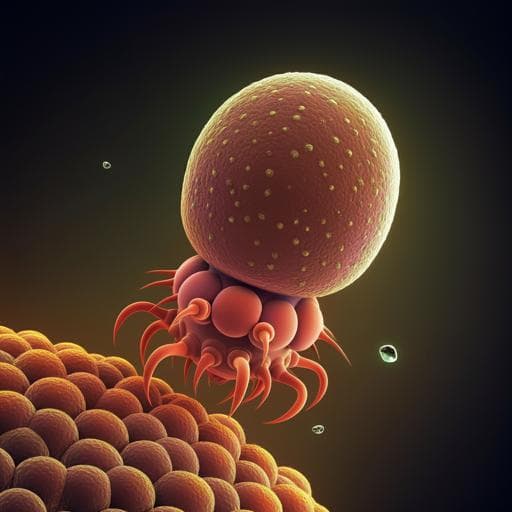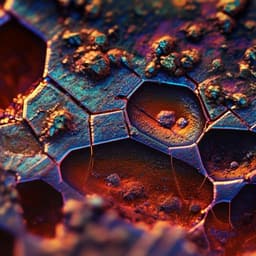
Biology
3D mechanical characterization of single cells and small organisms using acoustic manipulation and force microscopy
N. F. Läubli, J. T. Burri, et al.
Unlock insights into cellular mechanics with our groundbreaking study by Nino F. Läubli and colleagues. This innovative approach leverages an acoustically driven manipulation device to explore the mechanical properties of biological specimens like *Lilium longiflorum* pollen grains and *Caenorhabditis elegans* nematodes, revealing local variations in stiffness and enhancing biophysical modeling.
~3 min • Beginner • English
Introduction
Mechanical properties at tissue, cellular, and subcellular scales are key to understanding growth, morphogenesis, and interactions in biology and medicine. Many existing micromechanical methods (e.g., magnetic twisting cytometry, particle-tracking microrheology, optical stretching, parallel-plate rheology, AFM, and CFM) lack robust manipulation at microscales, limiting complete 3D access to individual samples and forcing assumptions or ensemble averaging. Rotational techniques based on magnetism, hydrodynamics, or optics often require specific sample properties, restricting general applicability. Acoustofluidics can manipulate diverse specimens biocompatibly. The study aims to overcome the 3D-access limitation by combining an acoustically driven, bubble-based manipulation device with micro-indentation force microscopy to trap, rotate, and mechanically probe multiple regions of single specimens, enabling comprehensive 3D characterization of individual plant cells (lily pollen) and a multicellular organism (C. elegans).
Literature Review
Prior work established diverse methods for single-cell and tissue mechanics: magnetic twisting cytometry, microrheology, optical stretching, parallel-plate rheology, and indentation-based AFM/CFM. However, these approaches generally lack full 3D manipulation, leading to partial coverage and reliance on multiple samples. Microscale rotation using magnetic, hydrodynamic, or optical fields has been demonstrated but typically depends on specific physical properties of the specimen. Acoustofluidic approaches, including surface acoustic waves, oscillating solid structures, and trapped microbubbles, have enabled mixing, sorting, and gentle manipulation/rotation with good biocompatibility. Mechanical indentation of pressurized shells shows sensitivity to geometry, curvature, and turgor pressure, complicating direct inference of material moduli from apparent stiffness. This work builds on these insights by integrating microbubble acoustics with CFM to achieve specimen rotation and localized indentation, and by employing FEM-based modeling to relate measurements to material properties and turgor pressure.
Methodology
Acoustic manipulation device and integration: An open-microchannel PDMS device with linear arrays of rectangular microcavities traps air microbubbles via hydrophobic/hydrophilic interactions upon liquid introduction. A piezoelectric transducer acoustically excites the trapped microbubbles to produce microstreaming vortices and radiation forces. Out-of-plane microstreaming enables stable 3D rotation of trapped specimens along their long axis. Operation is at low Reynolds number, allowing immediate stop without drift upon turning off excitation.
Cellular force microscopy (CFM): A MEMS capacitive force sensor (FemtoTools; various ranges such as FT-100 for soft hydrated pollen/C. elegans and FT-S10'000 for dry pollen) with a tungsten micro-indenter tip (<2 µm diameter) is mounted on a 3D positioner (closed-loop resolution 50 nm) for coarse alignment and a piezo flexure-guided nano-manipulator (closed-loop resolution 2 nm) for vertical indentation. The system measures force (F) and displacement (z); apparent stiffness k is defined as ΔF/Δz after correcting for system compliance (calibrated by indenting a hard surface). Indentation velocities (e.g., 4 µm/s) and maximum forces are controlled in LabVIEW. Typical single indentations take 10–15 s. Repeatability on biological samples yielded an average coefficient of variation of 4.8% (n=5 samples, m=50 indentations total) assessed on onion epidermis.
3D manipulation and indentation workflow: Specimens are introduced drop-wise to the open device; microbubbles trap and rotate them. Rotation is modulated by acoustic excitation; when the target orientation is reached the signal is stopped and the region is indented vertically (z-direction). For each pollen grain, multiple rotation-stop-indent cycles sample different surface regions. For C. elegans, multiple parallel bubbles provide trapping and controlled reorientation; lines of up to 11 measurement points spaced 20 µm along the body axis are indented at each orientation with a maximum force of 3 µN (maximum indentation depth ~10 µm) to avoid damage.
Plant model preparation: Lilium longiflorum anthers were stored at −80 °C. For hydrated experiments, pollen were rehydrated and submerged in either deionized water or 5 mM CaCl2 solution before loading near the PDMS device. Hydrated pollen dimensions: major axis 128.5 ± 9.9 µm, minor axis 98.3 ± 5.8 µm. For non-hydrated experiments, thawed pollen were kept at room humidity to remain dehydrated, then spread on a silane-coated glass slide to reduce slippage. For hydrated and non-hydrated pollen, the maximum indentation force was 10 µN.
Animal model preparation: Day-2 adult C. elegans (TJ375 strain expressing GFP in intestine after heat shock) were cultured at 20 °C on NGM with OP50. Prior to experiments, worms were heat-shocked to induce GFP, washed in M9 buffer, and paralyzed with 1 mM levamisole (5–10 min exposure) to suppress motion and increase muscle tone. During experiments, the probe moved longitudinally; indentation positions were corrected for any residual rotations.
Numerical modeling: FEM simulations using MorphoMechanX modeled a multi-layered pollen wall with intine (1.5 µm thick) and exine (0.5 µm) over an ellipsoidal shell inflated to turgor pressures P = 0.1–0.3 MPa to match average hydrated dimensions (128 × 97 µm unpressurized template). Indentations were simulated at the center of the colpus (intine) and opposite side (exine). Young’s moduli ranges tested: intine E_i = 5–100 MPa, exine E_e = 10–200 MPa. Apparent stiffness was computed at indentation depths of 1.6 µm (intine) and 0.6 µm (exine). An additional spherical-shell model varied wall thickness to interrogate the qualitative shape (sublinear vs superlinear) of indentation force–displacement curves, suggesting only fractions of the wall may be mechanically active at small indentations.
Data analysis and statistics: For each hydrated pollen, ~10 indentations were classified by region as intine (colpus) or exine. For each pollen, an apparent stiffness ratio k_i/k_e (mean intine over mean exine for that same specimen) was calculated to reduce inter-sample variance. Distributions were tested for normality; comparisons between water and CaCl2 ratios used appropriate statistical tests (significance threshold p < 0.05). For C. elegans, continuous maps of apparent stiffness around the circumference (angle θ) and along the body (distance from tail) were compiled from a single individual; softer versus stiffer bands were statistically compared.
Key Findings
- The platform enables non-invasive trapping, rotation, and localized indentation of single cells and small organisms with high repeatability (average CV 4.8%, n=5, m=50).
- Hydrated lily pollen in deionized water (n=30 pollen, m=300 total indentations): apparent stiffness mean ± SD for intine (colpus) 9.3 ± 4.4 N/m; exine 16.5 ± 6.6 N/m. Single-sample stiffness ratios k_i/k_e averaged 0.56 ± 0.10.
- Adding 5 mM CaCl2 increased the stiffness ratio significantly versus water (p = 0.000312), with the intine apparent stiffness averaging 0.66 times that of the exine, consistent with Ca2+-mediated pectin crosslinking specifically stiffening the intine.
- Dehydrated (dry) pollen exine: apparent stiffness averaged 194 N/m (m = 50 indentations on 50 independent grains), at least 5× higher than the maximum values for hydrated pollen, indicating strong softening upon hydration (e.g., swelling and matrix changes).
- FEM simulations best matched experimental intine data for turgor pressure P = 0.2 MPa and intine modulus E_i = 10 MPa, giving k_i ≈ 8.5 N/m (experiment 8.1 N/m). To approach exine measurements, a modulus ratio E_e/E_i ≈ 10 (E_e ≈ 100 MPa, E_i ≈ 10 MPa) yielded k_e ≈ 12.7 N/m (experiment 14.3 N/m), implying that apparent stiffness does not scale linearly with material modulus and is strongly influenced by geometry and pressure.
- Simulated indentation curves were sublinear, whereas experimental curves were more exponential; auxiliary models suggest only fractions of the wall may be mechanically engaged during small indentations.
- C. elegans 3D indentation on a single adult revealed alternating circumferential bands: softer k1 = 0.53 ± 0.07 N/m (n = 20) and stiffer k2 = 0.75 ± 0.11 N/m (n = 30), significantly different (p = 3.14e-10). Spatial correlation suggests stiffer bands overlie body wall muscles, whereas softer bands may correspond to regions above eggs/embryos where dorsal muscles are absent.
- The ability to rotate and map the entire surface avoids errors that can arise from 1D or single-orientation measurements, especially in multicellular organisms where subsurface structures influence apparent stiffness.
Discussion
The study addresses the lack of 3D access in microscale mechanical characterization by integrating a bubble-based acoustofluidic rotator with cellular force microscopy. This enables controlled reorientation and localized indentation of individual specimens, reducing reliance on ensemble averaging and improving spatial coverage. In lily pollen, full 3D characterization of each grain revealed robust intra-sample contrasts between intine and exine apparent stiffness and showed that computing per-grain ratios (k_i/k_e) reduces biological variance. Environmental modulation with Ca2+ increased intine stiffness relative to exine, consistent with selective pectin crosslinking. Dehydration dramatically increased apparent stiffness, highlighting hydration-dependent wall mechanics. Simulations linked measured apparent stiffness to plausible combinations of turgor pressure and wall moduli, indicating that a modulus ratio around 10 between exine and intine aligns with observations, but also emphasized that apparent stiffness is a complex function of geometry, pressure, and load sharing within layered walls. In C. elegans, 3D maps revealed significant circumferential heterogeneity likely influenced by underlying muscle tissues and internal organs. These results demonstrate that manipulating and probing multiple regions of the same specimen is essential to avoid misinterpretations from single-orientation measurements and to build more accurate biomechanical models of cells and organisms.
Conclusion
This work introduces a versatile platform that combines acoustically driven microbubble manipulation with force microscopy to achieve 3D mechanical characterization of individual cells and small organisms. It quantifies regional differences in lily pollen walls, demonstrates environmental (Ca2+) modulation of intine stiffness, shows strong hydration-dependent softening, and reveals significant circumferential heterogeneity in C. elegans likely linked to underlying musculature. FEM simulations provide mechanistic insight, relating apparent stiffness to turgor pressure and wall moduli and suggesting a substantial modulus contrast between exine and intine. Future work should improve microbubble temporal stability and control, incorporate enhanced imaging (e.g., side-view) for concurrent geometry capture, extend to complex 3D cellular aggregates (e.g., tumor spheroids), map developmental and aging-related changes in organisms throughout their life cycle, and rigorously quantify the effects of pharmacological immobilization and layered tissue contributions on apparent stiffness.
Limitations
- Microbubble temporal stability (shrinkage over time) leads to varying rotational velocities; device requires periodic cleaning/refilling to refresh bubbles. Longer microcavities may improve stability.
- Control of microstreaming strength is critical to avoid damaging the MEMS sensor or perturbing specimen orientation; safe probe–sample distances must be maintained (>20 µm during excitation).
- Apparent stiffness conflates contributions from geometry, turgor pressure, and layered materials; it is not a direct measure of material modulus. FEM models required simplifications (e.g., homogeneous exine) and may not capture all nonlinearities or partial wall engagement.
- Experimental indentation curves exhibit exponential characteristics not fully reproduced by current models (sublinear), indicating incomplete understanding of mechanically active wall fractions.
- Distributions of measured stiffness values can be non-normal; biological variability remains significant even with per-sample ratio analysis.
- C. elegans measurements were performed on a single specimen and under levamisole-induced paralysis, which alters muscle tone and may affect local stiffness; contributions from cuticle heterogeneity and internal organs are difficult to deconvolve without further studies.
Related Publications
Explore these studies to deepen your understanding of the subject.







